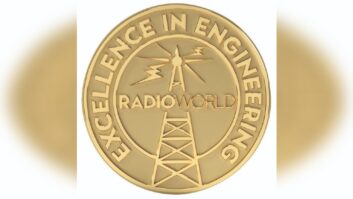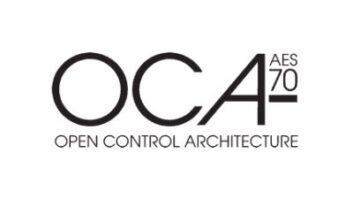IBOC Update – Oct 20, 2004
Oct 20, 2004 9:09 AM, By Mark Krieger, CBT

Stay up to date on the latest IBOC news, business and technology information with the twice-monthly newsletter from Radio magazine.
Index:
- Broadcast Electronics Works Both Sides of the Aisle at Radio Show
- Orban, Coding Technologies Team up to Demo 4th Surround System
- Broadcasters Catch Latest IBOC Developments At HD Radio Seminar
- Harrisburg New Home for Dielectric Interleaved Antenna
- TI Ships 1 Million Units to Eureka 147 DAB Market
- IBOC Across America
- IBOC Moves Into Motor City’s Fast Lane
- The Language of HD Radio
- Boston Acoustics Debuts First Home IBOC Receiver
To receive these articles twice a month in your e-mail, subscribe to the IBOC Update – Insight on HD Radio e-newsletter. Click here to subscribe.NewsBroadcast Electronics Works Both Sides of the Aisle at Radio Show
During the recent NAB Radio Show, Broadcast Electronics, a manufacturer of HD Radio products, played the role of systems integrator in several surround sound demonstrations on the exhibit floor. Among these was the new Fraunhofer format at the Telos Systems booth, as well as Coding Technology’s HDC Surround, showing for the first time in public at the Orban booth.Both exhibits ran 5.1 surround sound encoded by their respective technologies operating into Broadcast Electronics FXI digital FM exciters and Broadcast Electronics FSI 10 HD Radio signal generators.This summer, BE also participated in testing of the Fraunhofer format in Germany. In September, at its Quincy sound lab, BE conducted system testing of SRS Labs’ Circle Surround, (CS) a 6.1 surround sound format recently approved by Ibiquity Digital for HD Radio compatibility.”We’re at a point where integration is playing a much larger part, and of course broadcasters are going to look to the systems integrators building HD Radio stations to fill that role. That’s why we contacted BE for initial testing,” said Mike Canevaro, director of sales for SRS Labs.BE engineers are looking into equipment compatibility with the wide variety of surround sound technologies on the table, whether it be multiple stream or matrix audio techniques. “We are mainly interested in system compatibility at this point, so that when the industry does decide on a format, we’re not locking them out of the choice they make,” said Richard Hinkle, BE’s director of RF engineering.No systems integration issues have emerged among three of the four major contenders offering formats for HD Radio surround sound. The other contender, Neural Audio, is in partnership with Harris. BE has stated that it has no endorsement interest in any of the HD Radio surround sound formats.Orban, Coding Technologies Team up to Demo 4th Surround System
The Fall Radio Show provided a backdrop for yet another contender joining the race to establish a dominant standard for the transmission of IBOC surround sound. Coding Technologies, a provider of audio compression technology, and Orban, a well-known audio processing developer and manufacturer, premiered their HDC Surround solution at the Manchester Grand Hyatt in San Diego. Built on top of the HDC codec already used by HD Radio, HDC Surround claims to permit upgrading HD Radio broadcasts to 5.1 channel surround sound, while maintaining audio quality and compatibility for stereo-only receivers.Coding Technologies notes that with the HDC Surround system, broadcasters and receivers will need only a single codec to accomplish stereo and 5.1 channel broadcasts over HD Radio. Existing receivers will receive the broadcast as stereo and HDC Surround enabled receivers will receive the same broadcast as true 5.1 channel surround.”Matrix and watermark systems only provide a pseudo-surround experience, which is not true to the original 5.1 channel mix,” said David Frerichs, VP at Coding Technologies. “HDC Surround is a true 5.1 channel encoding system that preserves the mix and provides the maximum consumer experience for surround sound over HD Radio.””HDC Surround is designed to transmit 5.1 channel surround sound and still be compatible with today’s stereo receivers,” said Greg Ogonowski, VP of product development at Orban. “We are working with Coding Technologies to also ensure that HDC Surround can be deployed within a modern digital radio station without a complete overhaul of the existing stereo infrastructure.”Broadcasters Catch Latest IBOC Developments At HD Radio Seminar
Broadcasters eagerly discussed IBOC hybrid combining methods, upgrade paths for advanced applications and new studio installation options as they prepared for pending facility conversions by attending Broadcast Electronics’ HD Radio Seminar in San Diego on Oct. 6.BE’s Director of RF Engineering Richard Hinkle gave a detailed overview and fielded questions on combiner methods as well as on-the-fly operation, now possible with the latest HD Radio transmission technology.”Our upgrade approach is no new boxes,” said Hinkle to the 30-plus broadcast engineers in attendance. BE claims their FXI is currently the only exciter capable of functioning in a dual capacity for HD Radio and analog FM, enabling stations to change into digital or analog modes of operation on-the-fly and providing additional options for maximizing existing infrastructure.Later in the two-hour seminar, Ted Lantz, BE’s HD Radio product manager, gave a detailed presentation of the company’s Exgine, a new plug-in card to the FXI exciter for relocating encoding functions at the studio, and detailed functionality of BE’s new Radio Data Dimensions System (RDDS) for scheduling and trafficking data content over HD Radio.Discussions also turned to the 4MX 50 AM transmitter, BE’s new 50kW HD Radio-ready AM transmitter with advanced diagnostics. The new transmitter, which debuted at the NAB Radio Show, provides impedance sweeps of the antenna system and spectrum analysis of the output signal to verify spectral performance of a standard AM or HD Radio system, plus draws a Smith Chart plot and creates a spectrum plot for HD Radio implementation.BE says its HD Radio Seminars are presented as a courtesy and are designed to educate broadcasters and spotlight new developments in HD Radio technology.Technology/ApplicationsHarrisburg New Home for Dielectric Interleaved Antenna
Dielectric Communications has announced the successful installation of a HDR Series Interleaved Antenna System at WNNK 104.1 in Harrisburg, PA. The antenna is one of a new family that permits simultaneous transmission of analog and HD Radio signals from the same antenna aperture.The mountainous terrain surrounding WNNK’s transmission site provided engineering personnel an ideal test environment for the evaluation of multipath effects on hybrid analog/digital signals. Most significant among their observations was that the digital signal provided coverage superior to that of the analog signal in high multipath areas, while requiring just one-tenth the power for transmission.”We have recorded data for a number of test runs, and so far the results have been nothing short of fantastic,” said Chief Engineer Dave Supplee. “Our spectrum analyzer showed that where multipath conditions reduced the analog signal level substantially, the digital signal level was affected minimally. In many instances, the low-power digital displayed actual signal strength comparable to that of the high-power analog signal without any sign of interference.”The HDR Series Interleaved Antenna System, one of Dielectric’s high-efficiency, low-level IBOC combiner solutions, is comprised of two complete circularly polarized antenna arrays that are interleaved at halfwave intervals on a supporting structure. A reverse polarization technique maximizes the isolation between the analog and digital signals. At WNNK the separation is enhanced with the use of a low-power isolator.Because the tower geometry is identical for both arrays, the new antenna system is said to ensure a matching azimuthal coverage area for both analog and digital arrays.TI Ships 1 Million Units to Eureka 147 DAB Market
Dispelling rumors suggesting DAB’s growth curve has been thus far sluggish in Europe, Texas Instruments (TI) today announced that it has shipped one million digital radio baseband units for receivers in the Eureka 147 DAB market. Spurred by the launch of the first TI digital signal processor (DSP)-based module produced by technology partner Radioscape in September of 2003, TI held up this latest benchmark as proof that it is pacing the market.”We are very excited to get to the one million milestone in such a short space of time,” said Nigel Oakley, vice president of marketing at Radioscape. “The release of our range of modules has really accelerated the adoption of DAB and contributed to the record time of reaching one million units shipped …This has resulted in milestones such as the first MP3 and DAB player, the first FM/RDS DAB radio and the first tri-band DAB receiver. In addition, this software approach has enabled us to pioneer innovative features such as pause, rewind, record, Electronic Program Guide, 5.1 surround sound and video that can be implemented for nominal additional costs as these are done via software.”Some of the manufacturers that have built radios for the DAB market around TI’s analog and digital radio baseband solutions include Acoustic Solutions, Cambridge Audio, Hitachi, Intempo, LG Electronics, Morphy Richards, Perstel and Roberts Radio Limited.IBOC Across AmericaIBOC By State: Michigan
Ibiquity has a list of stations that have licensed HD Radio technology and notes those that are on the air now. IBOC by State will look at various states and list the stations that are making the transition.StationFormatMarketOwnerOn Air WEMU-FM 89.1 Jazz Ann Arbor Eastern Michigan University Yes WUOM-FM 91.7 News/Talk/Info Ann Arbor University of Michigan No WCHB-AM 1200 Gospel Detroit Radio One Yes WCSX-FM 94.7 Clsc Rock Detroit Greater Media No WDET-FM 101.9 NPR/Prgvs Detroit Wayne State University No WDMK-FM 102.7 Oldies Detroit Radio One Yes WDTJ-FM 105.9 Urban Detroit Radio One Yes WDTW-FM 106.7 Clsc Hits Detroit Clear Channel Radio Yes WJLB-FM 97.9 Urban Detroit Clear Channel Radio Yes WKQI-FM 95.5 Top 40 Detroit Clear Channel Radio Yes WMGC-FM 105.1 AC Detroit Greater Media Yes WMUZ-FM 103.5 Chrs Contemp Detroit Crawford Broadcasting Yes WMXD-FM 92.3 Urban AC Detroit Clear Channel Radio Yes WOMC-FM 104.3 Oldies Detroit Infinity Broadcasting Yes WRIF-FM 101.1 AOR Detroit Greater Media No WVMV-FM 98.7 SmJaz/NAC Detroit Infinity Broadcasting Yes WWJ-AM 950 News Detroit Infinity Broadcasting No WXYT-AM 1270 Talk Detroit Infinity Broadcasting Yes WFUM-FM 91.1 News/Talk/Info Flint University of Michigan No WVGR-FM 104.1 News/Talk/Info Grand Rapids University of Michigan No WKAR-AM 870 News/Talk Lansing-East Lansing Michigan State University No WKAR-FM 90.5 Cls/Flk/Jaz Lansing-East Lansing Michigan State University NoEye on IBOCIBOC Moves Into Motor City’s Fast Lane
Ibiquity Digital has announced that 10 additional radio stations in the Detroit market have recently commenced HD Radio operations, bringing the total number of digital AM and FM outlets airing IBOC digital in Detroit to 13.The AM/FM menagerie includes commercial formats such as news/talk, gospel, jazz, classic rock, urban, adult contemporary, top 40, oldies and Christian contemporary – as well as several non-commercial stations – all broadcasting in digital.This unprecedented concentration of IBOC digital radio marks the fruition of a concerted effort to bring digital radio to the eyes and ears of U.S. auto industry decision makers. With that goal substantially realized, the pending delivery of new vehicles featuring factory installed HD Radio audio is likely to be seen by consumers as an affirmation that digital radio technology is ready for prime time.”Broadcaster commitments from Clear Channel, Cox and Entercom have quickly led to the rapid station conversions we are witnessing in the Motor City,” said Jeffery McGannon, vice president of OEM business development, Ibiquity Digital. “An overwhelming majority of the city’s radio listeners can now take advantage of HD Radio broadcasts.” “We are always looking for innovative ways to stay in touch and serve our local audience and digital is the next step,” said Tom Bender, senior vice president and regional manager, Greater Media Detroit stations WMGC, WRIF and WCSX. “HD Radio technology will delight and amaze our Magic (WMGC) listeners�HD Radio is the most significant technological leap for our industry since the introduction of FM more than 40 years ago.”The Detroit stations now broadcasting HD Radio signals include:
WDTJ-FM 105.9
WDTW-FM 106.7
WEMU-FM 89.1
WJLB-FM 97.9
WKQI-FM 95.5
WMUZ-FM 103.5
WMXD-FM 92.3
WOMC-FM 104.3
WVMV-FM 98.7
WXYT-AM 1270
WCHB-AM 1200
WDMK-FM 102.7
WMGC-FM 105.1In addition, WDET-FM 101.9, WCSX-FM 94.7, and WRIF-FM 101.1 are expected to begin broadcasting in HD Radio before the end of the year, bringing the market total to 16 stations.HD Radio TerminologyThe Language of HD Radiohybrid IBOC: The first of three modes in the Ibiquity FM IBOC system that increases data capacity by adding additional carriers closer to the analog host signal. The hybrid IBOC mode adds one frequency partition around the analog carrier and is characterized by the highest possible digital and analog audio quality with a limited amount of ancillary data available to the broadcaster. Digital audio data rates can range from 64kbs/s to 96kbs/s, and the corresponding ancillary data rate can range from 33kb/s for 64kb/s audio to 1kb/s for 96kb/s audio.extended-hybrid IBOC: The second of three modes in the Ibiquity FM IBOC system that increases data capacity by adding additional carriers closer to the analog host signal. The extended-hybrid IBOC mode adds two frequency partitions around the analog carrier. In this mode, digital audio data rate can range from 64kb/s to 96kb/s, and the corresponding ancillary data rate will range from 83kb/s for 64kb/s audio to 51kb/s for 96kb/s audio.all-digital IBOC: The third of three modes in the Ibiquity FM IBOC system that increases data capacity by adding additional digital carriers. All-digital FM IBOC uses four frequency partitions and no analog carrier. In this mode, the digital audio data rate can range from 64kb/s to 96kb/s, and the corresponding ancillary data rate can range from 213kb/s for 64kb/s audio to 181kb/s for 96kb/s audio.ProductsBoston Acoustics Debuts First Home IBOC Receiver
The public got its first look at a table-top IBOC Radio, as Boston Acoustics presented its Recepter Radio HD with HD Radio technology to attendees at the NAB Radio Show in San Diego.The Recepter Radio HD is billed as a premium digital AM/FM table model, delivering high-fidelity sound comparable to “the finest radios ever made.” It broadens Boston Acoustics’ Recepter Radio line, and features dynamic HD Radio technology developed by Ibiquity Digital.”The introduction of this leading-edge, technology-driven, integrated audio solution reflects Boston’s history of engineering excellence�” said Moses Gabbay, Boston Acoustics president. “The Recepter Radio HD also reflects our concerted efforts to pursue new market and technology driven opportunities�”Ibiquity Digital President Robert Struble welcomed the Recepter’s introduction, noting that “consumers will (now) have their first opportunity to experience the many benefits of HD Radio technology in the home and at work,”Boston Acoustics is a manufacturer of high performance audio for home music, audio-video, automotive systems and custom audio system components. No word yet on price or retail shipping schedules.To receive these articles twice a month in your e-mail, subscribe to the IBOC Update – Insight on HD Radio e-newsletter. Click here to subscribe.












